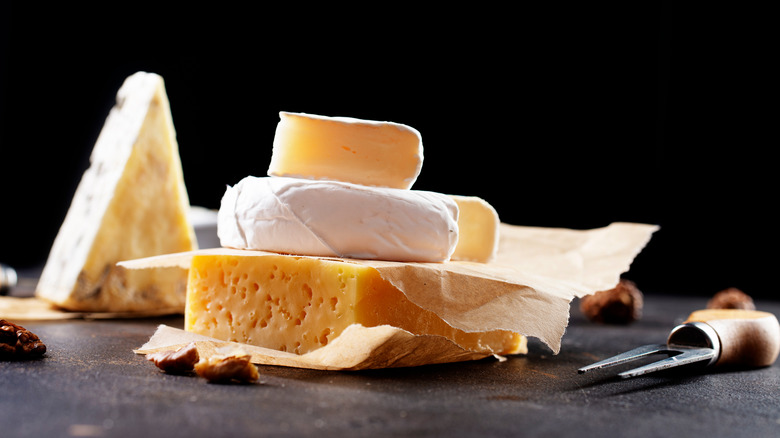Throw Your Cheese Away Immediately If You Notice This
Just because you spot a bit of mold on your cheese doesn't automatically mean you should toss it in the trash, but it is important to know when to cut your losses. According to the Academy of Nutrition and Dietetics, "mold is sometimes intentionally added to many cheeses as part of the ripening process." Think blue cheese and gorgonzola. Deciding what to save and what to discard depends more on the type of cheese involved. Business Insider explains that "when it comes to cheese, perishability has a lot to do with the moisture it contains."
Soft cheeses have more moisture and therefore spoil quicker than hard cheeses, so while it's generally safe to hack a hunk of mold off a block of aged cheddar or parmesan and keep eating the untainted remainder, it's ill-advised to devour a chunk of Brie or Camembert flecked with partial mold. This is because on a hard cheese, it's more difficult for mold spores to spread, meaning it's unnecessary to throw the whole piece away. In an interview with the Academy of Nutrition and Dietetics, Michelle Dudash, RDN, advised: "If you see mold on the outside of hard cheese like Parmesan or Cheddar, cut away at least one inch of the cheese around and below the mold to salvage the cheese."
Ooh, that smell
You also shouldn't discard your cheese just because it reeks like feet, although smell can be another sign to help detect if it has gone bad. Stinky cheeses are definitely a thing, and some varieties such as Limburger produce strong aromatics reminiscent of a ripe athletic sock that's just been worn in a 5K, while maintaining a surprisingly mild taste. Other cheese varieties intentionally incorporate the funk. According to the blog Food52, to create washed-rind cheeses, a rub of salt brine, liquor, or water is added during aging that "helps build that distinct funky flavor by creating an environment that attracts certain bacteria." Typically, these cheeses are also rather fragrant.
That being said, a lot of fresh cheeses don't emit much of an odor and there are certain situations in which a fetid smell is a red flag that a cheese is past its prime. Two indicators that your cheese has gone bad are "ammonia aromas and a rotting rind," which are characterized as "universal signs of a spoiled cheese." Another sign is a "smell or taste of spoiled, sour milk" (via Business Insider).
Now that you know what to look and smell for, it's time to focus on using those fresh cheeses to prepare some delectable dishes. If you just can't get enough of that ooey-gooey, creamy goodness, make sure to consult our list of recommended dinner recipes for the cheese obsessed.

